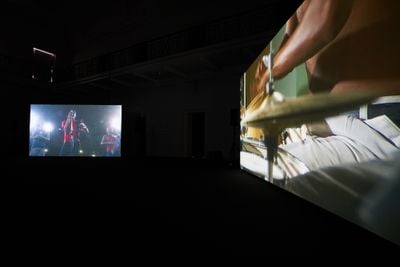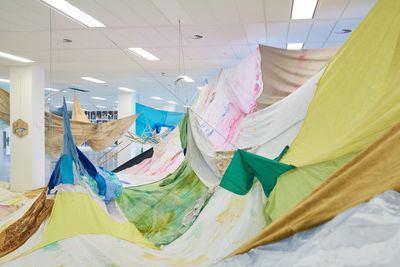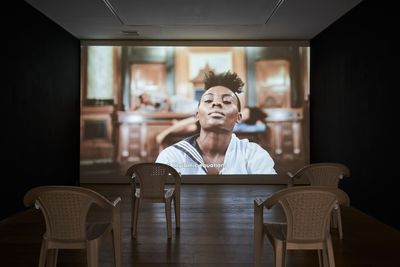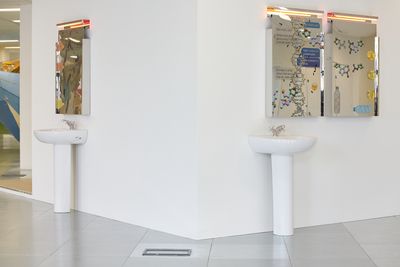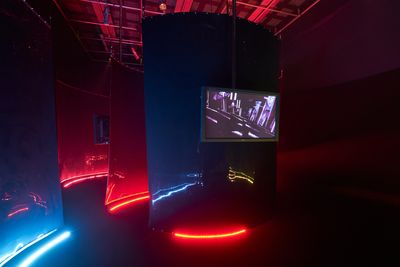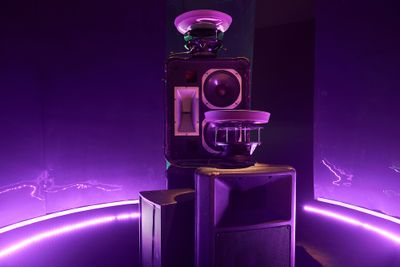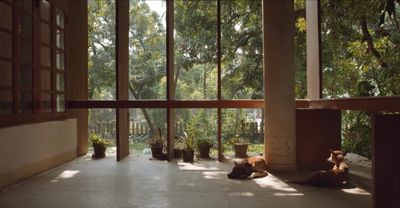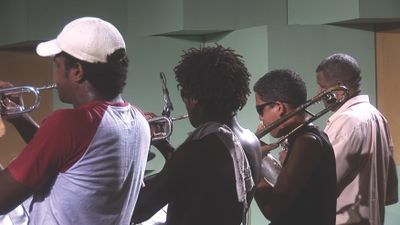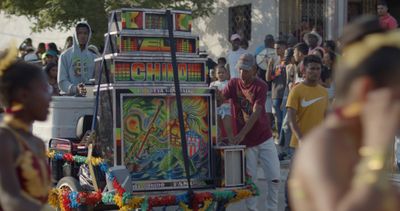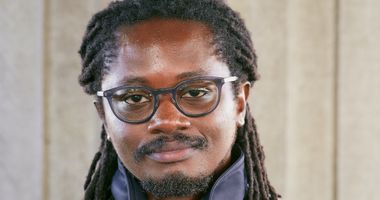Liverpool Biennial 2021 Draws History into the Present
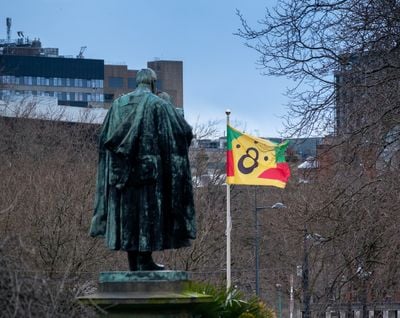
Larry Achiampong, Pan African Flag for the Relic Travellers' Alliance (2021). Exhibition view: The Stomach and the Port, Liverpool Biennial 2021, St. John's Gardens (20 March–27 June 2021). Courtesy the artist. Photo: Mark McNulty.
The 11th edition of the Liverpool Biennial (20 March–27 June 2021), The Stomach and the Port, spreads across nine exhibition venues as well as public spaces, taking inspiration from bodies as 'fluid, porous, and interdependent' sites, capable of all manner of atrocities, as they are care, joy, and resistance.
Curated by Manuela Moscoso, 50 works by international artists and two collectives draw on the 'stomach' and 'port' as interchangeable, each a nexus of passage and exchange. Throughout, Liverpool's role in the transatlantic slave trade is a consistent thread. Between 1700 and 1807, more than 5,000 voyages by Liverpool merchants were organised from the port, carrying nearly a million and a half to slavery in the Americas.
With its emphasis on porosity, the exhibition can be started from any one of its venues, each of which are free to access. My tour began in dissonance on the fifth floor of the 20th-century Lewis's Building—a former department store—with the frenetic slideshow and mural of images from Sohrab Hura's photographic projects 'The Coast' (2019) and 'The Lost Head and the Bird' (2017).
Described by the artist as 'a balloon into which I keep blowing air', 'The Lost Head and the Bird' is Hura's response to India's rising nationalism, consisting of hundreds of surreal, sometimes violent night scenes that move at a frenetic pace.
Turning around to explore the rest of the works on view on the vast fifth floor space, sheets of fabric comprising Reto Pulfer's installation hyperbolisch ratlos ortlos inhaltslos (2015–2021) are dyed with plant pigments in splashes of pink, blue, yellow, and green and hung from the ceiling at varying heights in the centre of the room.
It is somewhat cunning in its placement, separating the sound of Hura's installation as one passes through it, before the trickle of water from Luo Jr-shin's installation Like filter, matters passed through you and became a part of you (2021) melds with the sounds emanating from Alberta Whittle's film, between a whisper and a cry (2019).
Also being shown at Liverpool's dockyards at Open Eye Gallery, Whittle's film combines weather reports, footage of Divine Tasinda dancing to Sun Ra and His Arkestra's track 'Enlightenment', and archival footage, to consider the connection between the climate crisis and the legacy of slavery.
There is a sense to the arrangement. Pulfer's tent-like fabric installation draws attention to the exchange between the body and nature, itself inspired by the artist's memories growing up near Switzerland's largest landscape garden.
Luo's installation, on the other hand, connects the body with urban space, where walls surround a sticky floor, with sinks and mirrors on the outside, to recall nightclub bathrooms as places of exchange.
At times the sparsity of the gallery space is jarring, doing a disservice to some of the smaller works on view, including Alice Channer's series 'Soft Sediment Deformation' (2020), where crinkled crepe de chine has been printed with geological formations, their soft, zigzagging surfaces framed upon a wall that feels far from any of the other works on view.
With its use of sites formerly linked to the transatlantic slave trade, the Liverpool Biennial similarly draws the past into the present in an expansive exhibition that emphasises senses beyond the visual.
This sparsity is glaring on the second floor, which is empty for all but two works—Lamin Fofana's sound work Life and Death by Water (2021) and Zineb Sedira's large-scale photographic series 'Sugar Routes' (2013). Sedira's photographs capture piles of sugar housed in a warehouse in Marseille—silent giants that act as visual markers to the barbaric scale of the sugar industry, which continues into the present, having fuelled the slave trade from the 18th century.
While these photographs are placed in the corner of the exhibition space, it is Fofana's sound work that takes up space sonically, with recordings from Liverpool along with archival material rendered as a minimal composition that is inspired by the poem 'Zong!' (2008) by M. NourbeSe Philip, titled after the ship from which more than 130 African people were murdered upon the command of the ship's captain in 1781.
Consisting of a circle of stage monitors and scent machines, the presentation calls viewers to the here and now through sound and smell, with a sonic rumbling of crashing waves bringing viewers to the slave trade's present shores.
The use of sound as a means of resistance is furthered in Black Obsidian Sound System's (B.O.S.S.) immersive installation The Only Good System is a Soundsystem (2020) on view at FACT, showing until 29 August. The collective was formed in London in the summer of 2018 as 'a community of queer, trans and non-binary black and people of colour involved in art, sound and radical activism.'
Shortlisted for the 2021 Turner Prize, B.O.S.S. issued a public statement calling attention to the accolade's pitfalls in supporting artists who receive the prize, claiming institutions are 'not properly equipped' to provide financial support for social art practices due to 'the industry's in-built reverence for individual inspiration over the diffusion, complexity and opacity of collaborative endeavour.'
In a darkened room, the thud of music engulfs viewers in a maze-like formation of screens, lit from below with neon tubing, creating a club-like atmosphere. From speakers, different accounts of community and collective pleasure are recounted, each connecting to memories of music and working with sound systems to generate nights of music sometimes met with resistance from police and neighbours. Between these tales, music rushes, with at one point a voice repeating: 'between us we have everything we need'.
The formation of community is continued as a theme at the Bluecoat, where a presentation running until 5 September includes Daniel Steegmann Mangrané's video Fog Dog (2020). The film captures day-to-day activity at the Institute of Fine Arts of Dhaka in Bangladesh, which was designed by Muzharul Islam—a pioneer of modernist architecture in Bengal.
In this building, which was established in 1948—a year after the Partition of India—Mangrané's camera follows students, birds, and resident stray dogs in mellow natural lighting. The tranquil atmosphere is made up of sounds—the chirping of birds and insects, the call of prayer and the distant flow of traffic—and conversations that range from quotidian to more weighty matters.
In one scene, a teacher sits with a student while stitching muslin cloth, the production of which was suppressed by the British in the 19th century. 'The ancient traditions of our country were so rich', explains the woman. 'But now that mastery has been completely destroyed . . . your generation will regain this splendour.'
Over at the dockyards—the stomach of the U.K.'s transatlantic slave trade in the 18th and 19th centuries—two huge screens occupy the Dr. Martin Luther King Jr. Building, formerly the Dock Traffic Office. David Zink Yi's video installation Horror Vacui (2009) features a continuous loop of recitals by Cuban Latin band De Adentro y Afuera with scenes of Afro-Cuban rituals.
The work considers ritual, music, and religion as interwoven, with improvisation in musical rehearsals providing moments of resistance, where individuality is given space in opposition to oppressive power structures. The melding of cultures within music is expressed further at the former Cotton Exchange building, where Invernomuto & Jim C. Nedd's visual exploration of northern Colombian music in Grito – Las Brisas de Febrero (2021) centres on pico culture.
Set for the most part in Palenque—the first free African town in the Americas, established in the 17th century by those escaping enslavement—flamboyant pico sound systems float amidst crowds of people dancing, with the editing pattern of the film reflecting the patterns of hair braiding developed by slaves to transmit secret messages.
With its use of sites formerly linked to the transatlantic slave trade, the Liverpool Biennial similarly draws the past into the present in an expansive exhibition that emphasises senses beyond the visual.
Public installations draw it further into the city's fabric, including Larry Achiampong's four Pan-African flags spread across the city. Featuring green, black, and red bands and shapes, which represent Africa's land, as well as yellow-gold representing new prosperity, and 54 stars for each country on the African continent, the flags stand tall against dour 19th-century architectures, monuments, and histories yet to be reckoned with. —[O]

